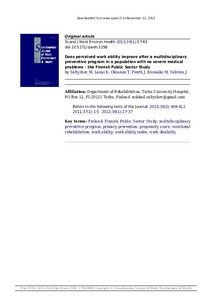Does perceived work ability improve after a multidisciplinary preventive program in a population with no severe medical problems? The Finnish Public Sector Study.
Saltychev M; Laimi K; Oksanen T; Pentti J; Kivimäki M; Vahtera J
https://urn.fi/URN:NBN:fi-fe2021042715277
Tiivistelmä
OBJECTIVES:
This study examines the short- and long-term effects of a multidisciplinary preventive program on perceived work ability in a population with no severe medical problems.
METHODS:
Altogether 859 public sector employees who participated in the program in 1997-2005 and their 2426 propensity-score-matched controls were studied prospectively. Propensity scores for probability of being granted participation in the program were calculated based on the data on health, health-risk behaviors, and work-related characteristics that were gathered from repeat responses to a survey, national health registers, and employers' records. Mean scores of perceived work ability (PWA) and prevalence ratios (PR) of suboptimal PWA were calculated after a short-term (mean 1.7 years, up to 4.6 years) and a long-term (mean 5.8 years, up to 9.2 years) follow-up.
RESULTS:
No beneficial effects were observed with respect to work ability. In comparison to controls, the participants' risk of suboptimal PWA was actually slightly higher after both the short-term [PR 1.23, 95% confidence interval (95% CI) 1.10-1.39] and long-term (PR 1.18, 95% CI 1.06-1.31) follow-ups.
CONCLUSIONS:
These data suggest that the vocationally oriented multidisciplinary preventive program was ineffective in improving work ability among participants with no severe medical problems.
Kokoelmat
- Rinnakkaistallenteet [27094]
